June 10, 2005
Sighting of cetaceans and marine birds during the crossing of the Atlantic.
The Oceana Ranger’s Transoceanic Expedition represents a magnificent opportunity to enjoy sightings of different species of cetaceans and marine birds. During the crossing of the Atlantic, between April 21st and June 9th, 2005, we were able to observe, and in most cases identify, diverse species of cetaceans and birds that, although a bit scarce in terms of numbers of individuals and species, it resulted interesting enough to us, in most cases.
Considering that the objective of the Oceana Ranger research in this crossing is not to register or investigate any of the groups ( cetaceans and marine birds ), sightings were done at random and without methodology.
In addition to the above, it must be pointed out that work conditions ( visibility and ocean climate conditions ) made it truly difficult to identify species in certain occasions.
Below, we indicate most species we considered to be of interest, including both marine birds and cetaceans.
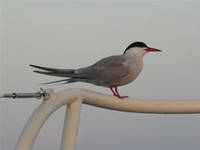
Marine Birds
-
Tuesday, May 3: Tropicbird ( Phaeton lepturus ), Wilson’s storm petrel ( Oceanites oceanicus ).
-
Sunday, May 15: upon leaving Bermuda, in the mangrove area, we sighted a great blue heron ( Ardea herodias ), Yellow-crowned Night-heron ( Nyctanassa violacea ) and White-tailed or Yellow-billed Tropicbird ( Phaeton lepturus ).
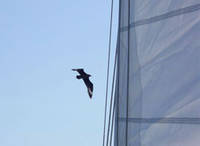
Monday, May 16: at 170 miles NE of Bermuda, we sigthed a Great Skua ( Catharacta skua ). This robust bird, similar to a seagull, large and of brown color, was hovering over the Ranger for two consecutive days.
-
Wednesday, May 18: Greater Shearwater ( Puffinus gravis ). There were sightings of this species almost every day as far as the proximity of the Azores Islands.
-
Friday, May 20: Roseate Tern ( Sterna dougalli ). This bird has a long and deeply splitted tail and a very pale coloration on the back and upper wings, which make it distinct from the common and arctic tern that may bo found in this area of the Atlantic Ocean.
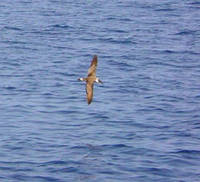
- Thursday, May 26: at around 175 miles from Azores, we sighted Cory’s Shearwater ( Calonectris diomededea ) who substituted the black caps. In the Azores, as it was the case with Madeira or the Canaries, the subspecies borealis ( C. diomedea borealis ) can be observed.
- Thursday, June 2: Common Tern ( Sterna hirundo ). A pair lands on the prow of the Ranger. During great part of the crossing, sightings of different species of Petrels was quite frequent, even if identifying the different species did not prove to be easy.
Cetaceans
Wednesday, May 18: Blue Whale ( Balaenoptera acutorostrata ). It is the smallest of whales. This, together with the blow hole, the coloration on the back and dorsal fin-relatively large respects to the size of the animal-helped us to identify the specimen.
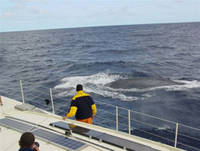 Thursday, May 19: Blue Whale ( Balaenoptera musculus ). Although the sighting of any cetacean in the middle of the ocean is always an indescriptibable experience, contemplating a blu whale swimming next to the hull of our ship goes beyond any expectation. The whale measured 12 to 14 meters long, so it was not an adult ( blue whales are the largest animals on the planet, reaching up to 30 meters in length and weighing 150 tons). This observation was confirmed by its ” daring ” or ” curious ” behavior, sometimes swimming between the two hulls of the Ranger. It literally breathed in our faces. It had a characteristic pigmentation and its body was conspicuously covered by spots. On the other hand, the very small dorsal fin ( almost vestigial ) and the form of the head left us little doubt.
Thursday, May 19: Blue Whale ( Balaenoptera musculus ). Although the sighting of any cetacean in the middle of the ocean is always an indescriptibable experience, contemplating a blu whale swimming next to the hull of our ship goes beyond any expectation. The whale measured 12 to 14 meters long, so it was not an adult ( blue whales are the largest animals on the planet, reaching up to 30 meters in length and weighing 150 tons). This observation was confirmed by its ” daring ” or ” curious ” behavior, sometimes swimming between the two hulls of the Ranger. It literally breathed in our faces. It had a characteristic pigmentation and its body was conspicuously covered by spots. On the other hand, the very small dorsal fin ( almost vestigial ) and the form of the head left us little doubt.

-
Saturday, May 21: At eight this morning we sighted a group of Atlantic spotted dolphins ( Stenella frontalis ), resurfacing again about twenty minutes later. We sighted a Killer Whale ( Pseudorca crassidens ). Also, we saw a whale ( Balaenoptera ) but we were not able to identify the species.
-
Sunday, May 22: Atlantic spotted dolphin ( Stenella frontalis ). A group of forty individuals showed up on the starboard wing, and then a group of twelve dolphins moved towards the prow of the ship, where they remained for several minutes. As the sun was going down, we could see a whale leaping out of the water, at a distance of about four miles away. The leaps were accompained by very powerful and explosive breaths. On occasion, it slapped the surface of the water with its caudal fin, and both the fin and the tail area were visible, despite the distance. Their general behavior made us think it was a Humpback whale ( Megaptera novaengliae ) although this is mere speculation.
-
Tuesday, May 23: In the morning, a group of common dolphin sighting ( Delphinus dolphins ) and around midday, we saw a whale we identified as a Mike Whale ( Balaenoptera acutorostrata ), although it is not an absolutely reliable identification.
- Thursday, May 26: we saw a group of common dolphins and breathing we identified as coming from a Sperm whale ( Physeter macrocephalus ). The breathing of a sperm whale is characteristic, because the blow hole is displaced to the left side of its head and the breathing forms an angle of 45 degrees.
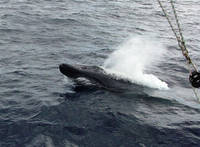
-
Thursday, June 2: Bottlenose dolphins sighting ( Tursiops truncatus ).
-
Friday, June 3: we sighted common dolphins ( Delphinus dolphins ). Several sightings throughout the afternoon.
-
Saturday, June 4: sighting of five unidentified whales; two were seen at eight in the morning and another group of three were sighted at eight thirty. All of them came from the larboard of the ship, moving towards the stern of the Ranger.
-
Tuesday, June 7: Five whales sighted ( a group of three and another of two ) at an interval of fofteen minutes. It was likely Fin whales ( Balaenoptera physalus ).

